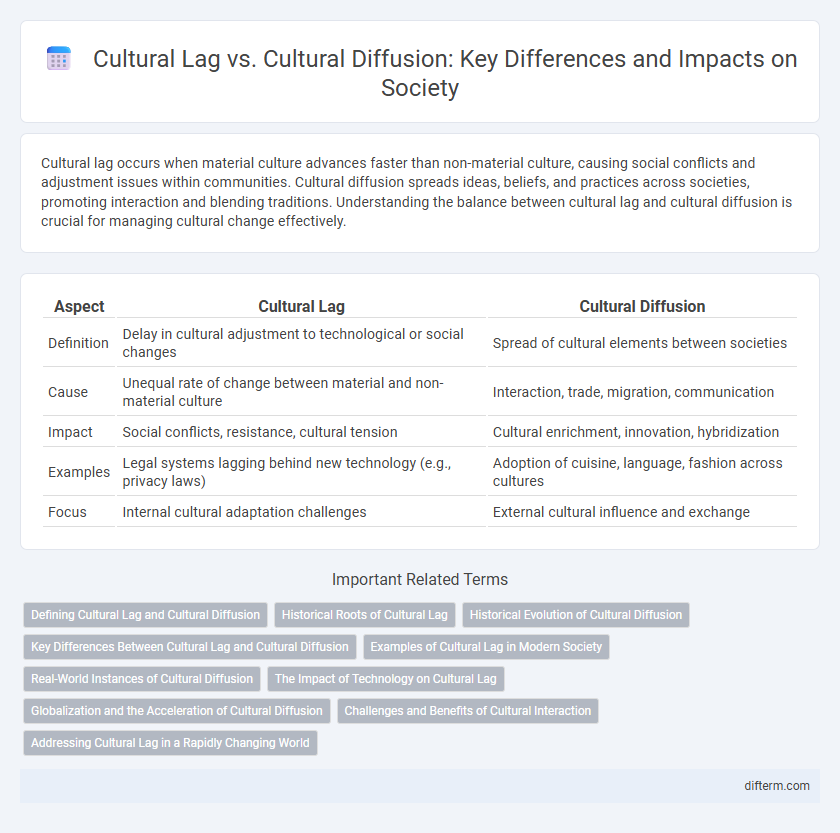Cultural lag occurs when material culture advances faster than non-material culture, causing social conflicts and adjustment issues within communities. Cultural diffusion spreads ideas, beliefs, and practices across societies, promoting interaction and blending traditions. Understanding the balance between cultural lag and cultural diffusion is crucial for managing cultural change effectively.
Table of Comparison
| Aspect | Cultural Lag | Cultural Diffusion |
|---|---|---|
| Definition | Delay in cultural adjustment to technological or social changes | Spread of cultural elements between societies |
| Cause | Unequal rate of change between material and non-material culture | Interaction, trade, migration, communication |
| Impact | Social conflicts, resistance, cultural tension | Cultural enrichment, innovation, hybridization |
| Examples | Legal systems lagging behind new technology (e.g., privacy laws) | Adoption of cuisine, language, fashion across cultures |
| Focus | Internal cultural adaptation challenges | External cultural influence and exchange |
Defining Cultural Lag and Cultural Diffusion
Cultural lag refers to the period of adjustment when non-material culture struggles to adapt to changes in material culture, causing a delay in societal acceptance or integration. Cultural diffusion involves the spread of cultural beliefs, practices, and innovations from one group to another, facilitating cross-cultural interaction and transformation. Understanding the dynamics of cultural lag and diffusion is essential for analyzing how societies evolve and respond to technological advancements and globalization.
Historical Roots of Cultural Lag
Cultural lag originates from sociologist William F. Ogburn's theory in the early 20th century, describing the delay between technological advancements and societal adaptation. This phenomenon highlights how social institutions, norms, and values often struggle to keep pace with rapid technological changes, resulting in temporary social disorganization. Understanding the historical roots of cultural lag provides insight into resistance to change and the challenges of integrating innovations within cultural frameworks.
Historical Evolution of Cultural Diffusion
Cultural diffusion, historically evident through the Silk Road and maritime trade routes, facilitated the exchange of goods, ideas, and technologies across civilizations, accelerating societal development. This process contrasts with cultural lag, where material innovations outpace the adaptation of social norms and institutions, causing temporal disparities in cultural acceptance. The historical evolution of cultural diffusion underscores its role in shaping global interconnectedness while highlighting challenges posed by cultural lag in the modernization of societies.
Key Differences Between Cultural Lag and Cultural Diffusion
Cultural lag refers to the delay in cultural adjustments when non-material culture struggles to keep pace with material innovations, often causing social conflicts, while cultural diffusion involves the spread of cultural elements such as ideas, customs, and technologies across societies, promoting cultural integration and change. The key difference lies in cultural lag emphasizing resistance and lag in adaptation within a culture, whereas cultural diffusion highlights the active transmission and assimilation of cultural traits between groups. Understanding these distinctions is crucial for analyzing social transformations in fields like anthropology and sociology.
Examples of Cultural Lag in Modern Society
Cultural lag occurs when technological advancements outpace society's norms and laws, such as the rise of social media creating privacy concerns without adequate regulations. Another example is the delayed legal response to genetic editing technologies like CRISPR, where ethical frameworks have yet to catch up. These gaps highlight the tension between innovation and societal adaptation in modern culture.
Real-World Instances of Cultural Diffusion
Cultural diffusion occurs when cultural elements like traditions, languages, or technologies spread from one society to another, driving social change and innovation. Examples include the global adoption of coffee originating in Ethiopia and the widespread practice of yoga developed in ancient India. These real-world instances demonstrate how cultural diffusion fosters interconnected societies by blending diverse cultural traits.
The Impact of Technology on Cultural Lag
Technological advancements often accelerate faster than societal values and norms can adapt, creating a cultural lag that delays integration into everyday life. This lag results in conflicts and challenges as communities struggle to reconcile traditional practices with new technological realities. Cultural diffusion, by contrast, facilitates the spread and adoption of technology by easing cultural barriers and promoting cross-cultural exchange.
Globalization and the Acceleration of Cultural Diffusion
Cultural lag occurs when material culture, such as technology, advances faster than non-material culture, including values and beliefs, creating social tensions. Globalization accelerates cultural diffusion by spreading ideas, practices, and innovations rapidly across borders through digital communication and international trade. This intensified diffusion challenges traditional norms and reduces cultural lag by promoting quicker adaptation and integration of diverse cultural elements worldwide.
Challenges and Benefits of Cultural Interaction
Cultural lag occurs when non-material culture struggles to catch up with rapid technological or social changes, creating challenges such as social resistance and ethical dilemmas. Cultural diffusion promotes benefits by facilitating the exchange of ideas, practices, and innovations between societies, enhancing diversity and fostering global interconnectedness. Both processes shape cultural interaction by balancing preservation of traditional values with adaptation to new influences.
Addressing Cultural Lag in a Rapidly Changing World
Addressing cultural lag in a rapidly changing world requires proactive adaptation strategies that align technological innovations with social values and norms. Emphasizing cultural diffusion facilitates the spread of new ideas and practices, helping societies close the gap between material change and non-material culture. Integrating education, policy reform, and community engagement accelerates cultural synchronization, promoting social cohesion amid transformation.
Cultural lag vs Cultural diffusion Infographic

 difterm.com
difterm.com